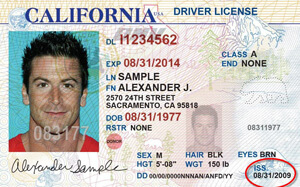- Updated for March 2025
- Based on 2025 CA commercial driver's license manual
Free DMV Ambulance Driver Written Test 2025
- Perfect for first-time and renewal CDL/CLP applicants, and those adding endorsements
- Triple-checked for accuracy
What you need to know

Helpful links
List of questions (classic view)
- "Code 3" transportation is most likely required for patients that have
- The primary responsibility of an ambulance driver is
- An ambulance driver must demonstrate the ability to safely operate an ambulance to
- When driving an ambulance under "Code 3", the driver should
- If your ambulance drivers certificate has been revoked for reckless driving, when are you allowed to reapply?
- You must not operate an ambulance when you are
- The driver is required to inspect the ambulance
- Smoking in the ambulance is
- While driving under “Code 3” exemptions, you may disobey a red light only
- Even if you have an ambulance driver certificate that has been renewed after December of last year, you may not respond to an emergency call
- Patients with _____ require low speed patient transportation.
- A trainee may be substituted for the qualified ambulance attendant
- Every ambulance driver must be trained to use all the required ambulance equipment and to assist the attendant in care of the injured
- When ambulances are readily available from two or more services, your ambulance company may respond to a motor vehicle accident
- Studies have shown that sirens on emergency vehicles do not give sufficient warnings to
- The decision to use high speed patient transportation requires sound judgement, because high speed may
- In order to maintain a valid ambulance driver certificate you must pass a physical exam
- When a qualified attendant is not readily available, the driver's responsibility is to
- The amber warning lights on the ambulance may be displayed only
- The red warning lights on the ambulance may be displayed
- Who is responsible for the mechanical safety of an ambulance?
- A tire with the tread depth of less than ____in any two adjacent grooves must not be used on an ambulance.
- When transporting a stabilized patient, the driver should
- Unless specifically exempted, a new ambulance driver must obtain a valid EMT-1(ambulance) certificate
- Your ambulance drivers certificate may be denied or revoked if you are convicted of
- A conviction that has been set aside or dismissed following probation as permitted by Penal Code Section 1203.4
- Who has the main authority for managing the scene of a traffic accident that involves injuries?
- While driving under “Code 3” exemptions, which hazards shoud you anticipate?
- A temporary Certificate becomes void after
- What is the most urgent Code?
- How often are fire extinguishers to be inspected and serviced?
- What are the conditions for driving under "Code 3" exemption ?
- What are the essential signs and conditions for the special exemptions from the basic traffic laws?
- What are the drivers legally required to do when an ambulance is approaching with its lights flashing?
- When is it necessary to display a steady red light on an ambulance?
- What is/are the primary rule/s of high speed driving?
- When following another vehicle, the following distance should be
- Which of the following statements is FALSE?
- If you must back your ambulance, you must station an observer
- "Code 3" is prohibited by the regulations
- The minimum supply of oxygen required when responding to an emergency call is
- A utility floodlight on the ambulance may be displayed when
- Driving under "Code 3" may be justified for the following reason(s):
- When using a siren, an ambulance driver should
- Warning lamp effectiveness may be reduced by
- The driver should look _____ before entering an intersection.
- Which of the following statements is FALSE?
- All reusable medical supplies should be kept
- To protect against HIV, hepatitis B, each ambulance must be equipped with
- In city traffic, a driver with car windows open and no radio playing might not detect the siren more than _____ feet away.
- When backing up, an ambulance driver should
- Alabama: Test 1 / Test 2
- Alaska: Test 1 / Test 2
- Arizona: Test 1 / Test 2
- Arkansas: Test 1 / Test 2
- California: Test 1 / Test 2
- Colorado: Test 1 / Test 2
- Connecticut: Test 1 / Test 2
- Delaware: Test 1 / Test 2
- District of Columbia: Test 1 / Test 2
- Florida: Test 1 / Test 2
- Georgia: Test 1 / Test 2
- Hawaii: Test 1 / Test 2
- Idaho: Test 1 / Test 2
- Illinois: Test 1 / Test 2
- Indiana: Test 1 / Test 2
- Iowa: Test 1 / Test 2
- Kansas: Test 1 / Test 2
- Kentucky: Test 1 / Test 2
- Louisiana: Test 1 / Test 2
- Maine: Test 1 / Test 2
- Maryland: Test 1 / Test 2
- Massachusetts: Test 1 / Test 2
- Michigan: Test 1 / Test 2
- Minnesota: Test 1 / Test 2
- Mississippi: Test 1 / Test 2
- Missouri: Test 1 / Test 2
- Montana: Test 1 / Test 2
- Nebraska: Test 1 / Test 2
- Nevada: Test 1 / Test 2
- New Hampshire: Test 1 / Test 2
- New Jersey: Test 1 / Test 2
- New Mexico: Test 1 / Test 2
- New York: Test 1 / Test 2
- North Carolina: Test 1 / Test 2
- North Dakota: Test 1 / Test 2
- Ohio: Test 1 / Test 2
- Oklahoma: Test 1 / Test 2
- Oregon: Test 1 / Test 2
- Pennsylvania: Test 1 / Test 2
- Rhode Island: Test 1 / Test 2
- South Carolina: Test 1 / Test 2
- South Dakota: Test 1 / Test 2
- Tennessee: Test 1 / Test 2
- Texas: Test 1 / Test 2
- Utah: Test 1 / Test 2
- Vermont: Test 1 / Test 2
- Virginia: Test 1 / Test 2
- Washington: Test 1 / Test 2
- West Virginia: Test 1 / Test 2
- Wisconsin: Test 1 / Test 2
- Wyoming: Test 1 / Test 2
Your go-to, trusted source
Experience the Driving-Tests differenceOur commitment to accuracy and quality in our practice tests
Explore our rigorous, multi-tiered verification process that ensures each question mirrors the official manual for unparalleled accuracy.

At Driving-Tests.org, we understand the importance of reliable and accurate practice tests to help you prepare for your DMV exam. That's why we've developed a meticulous process to create and continually update our practice questions, ensuring they reflect the most current driving laws and regulations.
Here's an inside look at how we maintain the highest quality in our practice tests.
Content Creation and Verification Process
- Alignment with Official Manuals:
Every question we develop is based on the most recent version of each state's official driving manual. Our team regularly monitors each state DMV's website for the latest updates to ensure our practice tests are always aligned with the most current information. - Community Feedback Integration:
We leverage feedback from our vast community of users to understand which topics are most frequently tested. This helps us focus on the areas that are most relevant and beneficial for your preparation. - Expert Content Creation:
Our in-house editor, Steven, who has extensive experience in driver education, crafts each question with precision. He conducts a thorough review of each question against the official manuals to ensure accuracy. - Rigorous Review Process:
Once Steven has finalized a set of questions, our team conducts a joint review session. This second level of scrutiny involves content accuracy, proofreading, and fact-checking to eliminate any errors. - User Feedback Mechanism:
After a question goes live on our site, we keep the lines of communication open. Each question features a feedback button, inviting users to report any issues or errors. This continuous feedback loop allows us to address and rectify any concerns promptly. - Responsive Updates:
In line with our commitment to accuracy, we quickly update our practice questions to reflect any changes in the DMV manuals. Additionally, we update the free electronic copy of the state's driver's license manuals on our site, typically within a few days after the DMV publishes them.
Our thorough quality control process ensures that you have access to practice tests that are as accurate and up-to-date as possible. We believe in the power of well-prepared drivers and are dedicated to providing you with the best study tools to help you succeed on your DMV exam.
Pass the First Time – Guaranteed
You’re moments away from your results.
Before you view them, see how 1.15 million drivers used Premium to pass faster.
Real Exam-Like California Questions
Get all exam-like questions seen on the real test.
99.06% Pass Rate vs. 49% Average
Most Premium users pass on their first try.
Money-Back Guarantee
We stand behind you until you pass.




